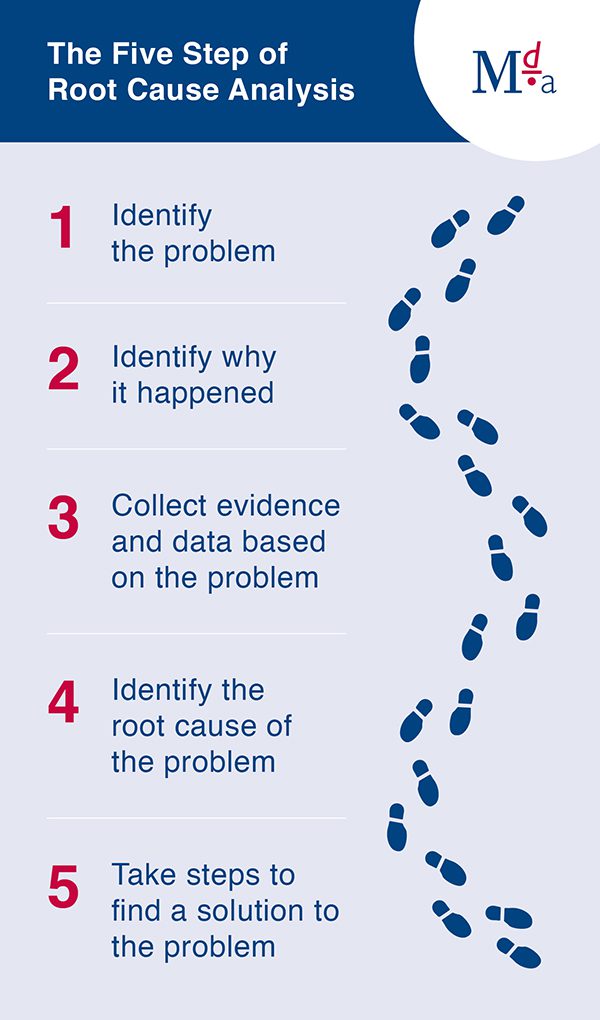Key takeaways
- Root cause analysis can be applied to solve almost any problems or issues in the workplace.
- Adopt a five-pronged approach to conducting root cause analysis.
- You can communicate better and improve on solving problems with a dedicated training programme.
Root cause analysis can prove to be an incredibly effective method of identifying problems within a business, as well as highlighting any areas for long term improvement.
It is possible, however, for businesses to waste their efforts in attempting to solve problems by not setting a clear focus for their root cause analysis. The backlash of this is that companies are spending their time and resources on something that may not even solve the problems they are experiencing.
To help you solve problems more efficiently, we have outlined what a root cause analysis is, how it is beneficial, and how you can take steps to apply it immediately within your business.
What is root cause analysis?
Root cause analysis is a step-by-step process which allows you to clearly identify the ‘root’ cause of a problem, as well as putting steps into place to avoid it happening in the future. Rather than just issuing a short term fix, root cause analysis offers useful ways in which to prevent issues from reoccurring.
Every business will encounter different problems throughout their lifecycle, many of which can be challenging to identify and solve. To maximise the chances of moving forward, root cause analysis should be both precise and accurate.
How can root cause analysis benefit businesses?
The beauty of using root cause analysis to solve a problem in the workplace is that it can be used as a template and guide for future problems, thus saving considerable amounts of time and effort.
In addition, they will encourage employees and those in management to identify and assist in solving issues together, which allows for greater communication across an entire hierarchy.
How to conduct root cause analysis
There are several methods and techniques used by professional organisations to conduct a thorough analysis. We recommend using a five-pronged approach, which is similar but not identical to the ‘five whys’ to solve a problem successfully.
The five stages are:
- Identifying the problem
- Identifying why it happened
- Collecting evidence and data based on the problem
- Identifying the root cause
- Taking steps to find a solution to the problem.

1. Identify the problem
Before anything else, those in positions of authority must be able to clearly identify any problems that have arisen within the business before taking steps to solve them.
These problems can be related to several areas, including financial performance, workplace morale and productivity, to name a few. Whatever the issue is, it needs to be identified along with the specific symptoms of the problem at the beginning of root cause analysis.
2. Identify why it happened
While there may be several reasons why a problem may have occurred in the first place, it is important to focus solely on the answers that are rooted in fact, as opposed to speculation.
For example, if the problem in question is that an internal deadline was missed, the first ‘why’ could be that the job took longer than anticipated. From here, it becomes easier to collect evidence to further identify the issue.
3. Collect evidence and data based on the problem
Before identifying the root cause of any issues, business leaders need to be entirely sure that the problem exists enough to cause disruption, and later gather evidence to prove its negative impact on the company.
While this can be difficult to do, especially when it comes to internal and personal matters, it will be inherently more difficult to identify and solve the root cause of a problem without clear data to suggest that it is indeed one.
4. Identify the root cause of the problem
After collecting the relevant evidence, the next stage of root cause analysis will be to identify precisely what is causing the problem. Business leaders should be asking themselves based on the evidence they have collated:
- What has happened to cause this problem?
- What working conditions have allowed this problem to occur?
- What is the backlash of this problem?
Once the problem has been clearly identified, along with the cause, it becomes easier for leaders to begin solving the issue.
5. Take steps to find a solution to the problem
This stage will, of course, vary on the severity of the problem along with who or what will be affected by any subsequent action taken. Ultimately, however, business leaders should be able to take steps to prevent the problem from happening again, as well as how the solution will be implemented.
Care should also be taken to assess the risk of implementing a solution following root cause analysis, as there may be knock-on effects which may cause even more significant problems for the wider company.
For more information on the method of the five whys, please watch this helpful video below:
Can root cause analysis be improved with workplace training?
While many business leaders will be familiar with root cause analysis and how to solve problems efficiently, it is important to be able to use this method across an entire hierarchy, and can therefore be improved as part of a dedicated workplace training course.
At MDA Training, we provide management development training courses that can be conducted using Zoom, WebEx or Teams, focusing on communication and instilling a culture throughout an entire company that will drive positive change.
Summary
Identifying and fixing problems in the workplace does not have to be an impossible task for business leaders. When a clear focus is presented on dealing with the problem head-on as part of root cause analysis, the process becomes much more straightforward.
Furthermore, once business leaders have solved one problem using a clear structure, future issues that may arise will become easier to solve.









